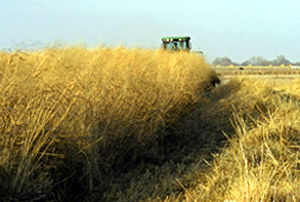USDA: New Switchgrass Variety Promises More Biofuel at Lower Cost
 According to the USDA’s Agricultural Research Service (ARS), Washington, D.C., USA, the release of a new type of switchgrass specifically designed for bioenergy generation has been announced by USDA researchers and their partners. Agricultural Research Service (ARS) scientists have spent decades working on different projects that contributed to the development of the cultivar "Liberty," which can yield eight tons of biomass per acre.
According to the USDA’s Agricultural Research Service (ARS), Washington, D.C., USA, the release of a new type of switchgrass specifically designed for bioenergy generation has been announced by USDA researchers and their partners. Agricultural Research Service (ARS) scientists have spent decades working on different projects that contributed to the development of the cultivar "Liberty," which can yield eight tons of biomass per acre.
The ARS is USDA's chief intramural scientific research agency, and this research contributes to the USDA’s priority of developing new bioenergy sources.
The release of the new cultivar is a significant milestone for ARS. It's also a key accomplishment for CenUSA Bioenergy, a project funded by USDA's National Institute of Food and Agriculture, which is tasked with developing perennial bioenergy production systems in the Midwest. An announcement about Liberty was published in the Journal of Plant Registrations in June.
ARS researchers who contributed to Liberty's development include retired geneticist Ken Vogel, agronomist Rob Mitchell, molecular biologist Gautam Sarath, and geneticist Michael Casler. Mitchell and Sarath work at the ARS Grain, Forage and Bioenergy Research Unit in Lincoln, Neb., and Casler works at the U.S. Dairy Forage Research Center in Madison, Wis. Liberty contains traits from southern lowland switchgrass types that result in high yields, as well as traits from northern upland switchgrass types that support winter hardiness. In a 16-year breeding study, the new cultivar increased biomass production by as much as 43% compared with the parent lines.
Another plus with the new cultivar is that gains in yield were achieved without an increase in nitrogen fertilizer use, which helped lower expected production costs on the farm by approximately $20 to $30 per ton. With the increased yields, each acre of switchgrass could now be used to produce 75 to 160 more gal. of ethanol.
The development of Liberty followed several ARS investigations into the evolutionary patterns of switchgrass, which is a native North American perennial with a highly complex genome. This work has resulted in the identification of eight regional gene pools with traits that could be useful in developing switchgrass varieties for different production environments.
TAPPI
http://www.tappi.org/
 According to the USDA’s Agricultural Research Service (ARS), Washington, D.C., USA, the release of a new type of switchgrass specifically designed for bioenergy generation has been announced by USDA researchers and their partners. Agricultural Research Service (ARS) scientists have spent decades working on different projects that contributed to the development of the cultivar "Liberty," which can yield eight tons of biomass per acre.
According to the USDA’s Agricultural Research Service (ARS), Washington, D.C., USA, the release of a new type of switchgrass specifically designed for bioenergy generation has been announced by USDA researchers and their partners. Agricultural Research Service (ARS) scientists have spent decades working on different projects that contributed to the development of the cultivar "Liberty," which can yield eight tons of biomass per acre.